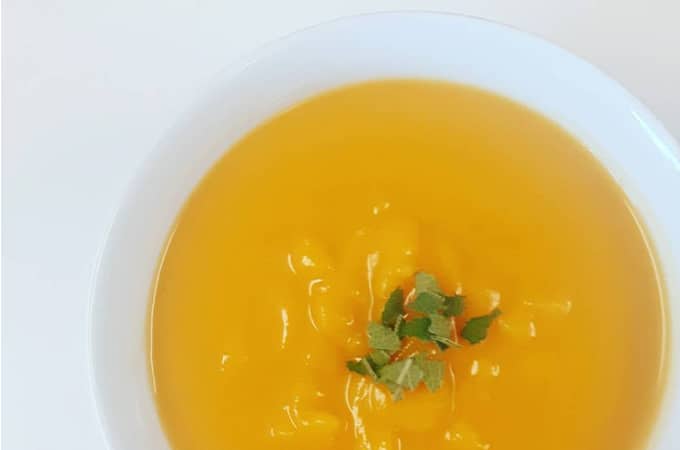
Diversity in AIP is a story series showcasing the wide variety of people from different backgrounds adapting AIP to not only support autoimmune healing, but also to honor important cultural, religious, ethnic, or national food traditions. We are sharing these stories regularly to encourage folks of similar backgrounds to join our Autoimmune Wellness movement and to inspire the community as a whole about the growing reach of our healing message. If you are interested in sharing your story, please let us know by filling out our interest form.

This month’s “Diversity in AIP” story comes from Natalie. Natalie has Caribbean roots and discovered AIP after a diagnosis of a rare autoimmune condition, lichen planopilaris. She has been very creative in the kitchen and thanks to a supportive family helping with recipe testing, she is enjoying more of the foods from her childhood than ever before.
Do you have an autoimmune disease or chronic illness? If so, how long have you been dealing with it (them) and when did you get your diagnosis?
I was diagnosed with Lichen Planopilaris in November of 2016. Lichen planopilaris is a rare inflammatory condition that results in patchy progressive permanent hair loss on the scalp. It is considered to be an autoimmune disease.
I first noticed hair loss (a small bald spot on the back of my head) in the last part of 2011. This was immediately after my mom was diagnosed with lymphoma. Years later I learned about how emotional trauma or stress can manifest physically in people and made the connection between my mom’s diagnosis, her stressful two years of treatment to follow, and my hair loss. At the time, I joked about how my hair was falling out in solidarity.
The hair loss has slowly worsened over the years with flares (burning and itching spells on my scalp that would last for days) occurring in recent years. In the last year, I have ended up with two significant areas of hair loss. I have seen three dermatologists since 2011 and was briefly under the care of one until shortly after my diagnosis. The doctor and I did not see eye-to-eye on treatment options. His treatment recommendation: steroids or hair transplant and his team did not believe that diet could impact my lichen planopiliaris in a positive way. My treatment recommendation: diet and lifestyle.
Over the next few months I decided to leave that doctor’s care and focus on diet and lifestyle as my remedy. I came to the point that I would feel better about this course of action even if it did not stop the hair loss or the bald patches did not fill in versus using drugs as treatment (which are not guaranteed to work either). I think that most important thing I learned was I need to be my own health advocate.
When did you discover AIP and what was your first indication that it was working for you?
I discovered AIP in November 2016 through obsessive googling. Late night googling had become a regular part of my life since my diagnosis. I was given the option of steroids as the course of treatment. I immediately opted against based on side effects related to steroids, plus they were not guaranteed to work.
At that time I was intimidated by the Protocol, as I was unsure that I would be able to successfully follow it. I instead opted to follow the Anti-inflammatory Diet. I was a bit hap-hazard only following the diet, basically at home but not at restaurants and other people’s homes. It helped me cut down my consumption of gluten, nightshade vegetables, sugar and alcohol. I feel it made it easier to transition to AIP in June of 2017. I followed the strict protocol for 30 days. By August I began to notice positive changes that I hadn’t expected, I did not consider that I was experiencing gut issues previously, but I was. I was now less bloated, had improved digestion, became regular, I had more energy and I believe I looked better than ever.
In terms of my hair the progress has been slow. At the end of August, I stopped the topical natural hair regimen that I’d been doing for the previous nine months. By October I could tell that hair fall had stopped. Re-growth is happening in my two main bald patches and throughout the thinning areas. I’ve only experienced one mini-flare since beginning the diet, which was immediately after reintroducing a couple foods at once. I’m patient and optimistic since I feel that I’m doing the best for my body. I’ve incorporated lifestyle aspects into my AIP wellness journey including yoga, meditation and rest. I work hard to remain focused and dedicated. I feel that all of this along with the support of my family and friends is the key to my positive progress.

Can you share some adaptations you’ve made to special dishes to make them work with AIP?
I grew up in a house where the kitchen was the heart of the home. Both of my parents are of Caribbean decent, my mom is from Grenada by way of England and my dad is from Barbados. My mom is a wonderful cook who has always shown love by feeding people whether it’s our family or guests who visited our house. Mom cooked tons of Grenadian and Bajan (nickname for the people of Barbados) foods. Grenada is known as the spice isle, the food is full of spices from cinnamon, cloves, etc. Bajan food on the other hand is full of hot spice. Bajan pepper spice sauce is a staple in the cuisine.
I’ve always loved cooking and baking with mom. Since beginning AIP we cooked together a few times revamping a few of our family favorites including Bajan Cou Cou, as well as Fish Cakes. Cou Cou is similar to polenta or grits, Cou Cou is made with corn meal and okra. As I was researching modifications I discovered there are versions of Cou Cou that are made without corn meal. I found a great recipe using green bananas which turned out fabulous and won the seal of approval of my parents.
Revamping the Fish Cakes was another story, it’s been a work in progress. Fish Cakes are traditionally made with wheat flour, egg, tons of hot pepper, and fried in canola oil. I’ve made a few versions using different flours, arrowroot or coconut and also white sweet potato, lots herbs and coconut oil for frying. We created a tasty, not as spicy Fish Cake, but are still working on the consistency.

Are there any foods that were part of important food traditions you followed previously, but still work great within the AIP framework?
One part of Caribbean cooking that is common amongst all islands is one pot meals or hearty soups. The best part about these dishes is that you can create them with all the ingredients you love and work for you. The recipe is whatever you would like to include. My favorite ingredients are various types of squash and root vegetables like eddoes and sweet potato. The only difference is that now I make my soups with a base of bone broth.
Plantains, fried or baked have always been a fav. I eat them more than I ever have before. Liver is something that my mom used to make for me a lot when I was growing up. It has worked its way back into my diet.
Has it been difficult to garner the support of family or friends in your culture, religion, ethnicity or country, while following AIP? If so, what tips would you give to others from your same background who want to try AIP?
My friends and family are supportive of doing what I need to do to be healthy. My mom has used diet to heal in the past, after her cancer diagnosis. We believe diet and self-care played a big part in her ability to overcome that disease.
The good thing is that it’s not that hard to adapt the dishes to become AIP-compliant. In some cases, it may be an interpretation of a Caribbean dish. Many of the traditional vegetables staples (called provisions in the Caribbean) yams, pumpkin, sweet potatoes, dasheen root, eddoes and cassava, plus the green vegetables like callaloo and collard greens are AIP-compliant. It will take some small adjustments to some flavors (no hot pepper sauce), ingredients (cauliflower rice instead of rice), and cooking methods (using new oils like coconut and avocado). It may seem daunting at first, but it gets easier each day. It’s all worth it the moment when you begin to feel better. I feel it is worth investigating as an option for healing.
Did any aspect of your healing journey with AIP deepen your connection to your culture, religion, ethnicity, or nationality and the food traditions it follows?
As much as I love the Caribbean foods that I grew up with, I didn’t eat them every day as an adult. When I began AIP, I started to experiment with food more. I now love making new dishes as well as versions of childhood family favorites. Opposite to what most people think, I’d say my diet has actually expanded since I discovered AIP.
If you’d like to follow Natalie on her AIP journey, you can find her on Instagram at @thatafropaleogirl.
Would you like to share your Diversity in AIP story? Let us know by filling out our interest form.
















2 comments
Thank you so much for sharing this! It’s fantastic to hear that you have had regrowth. I am currently on the aip diet and have been diagnosed with LPP too, so this is just so encouraging. Thanks again, Helen
Hi again, I would be very grateful to know which topical natural hair regimen you used. I recently had an appointment to discuss the LPP. I have been working hard on the diet and went in feeling quite optimistic, but I have been feeling a little demoralised since then. Many thanks